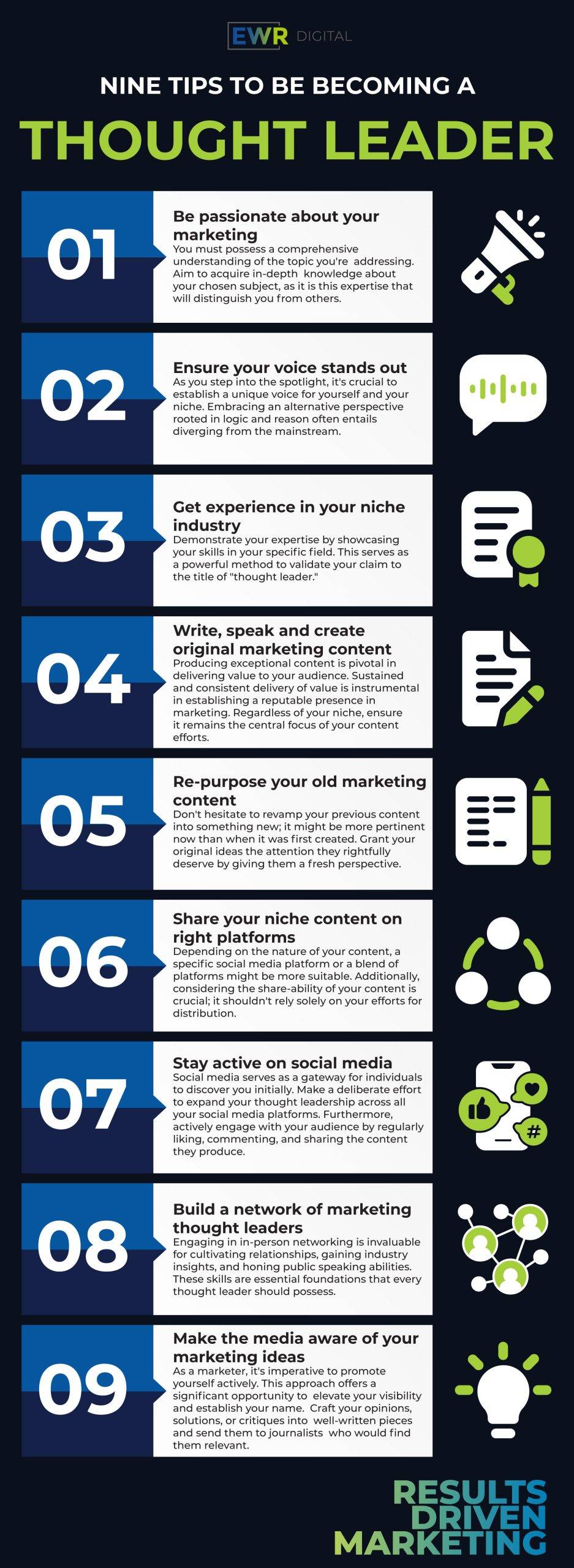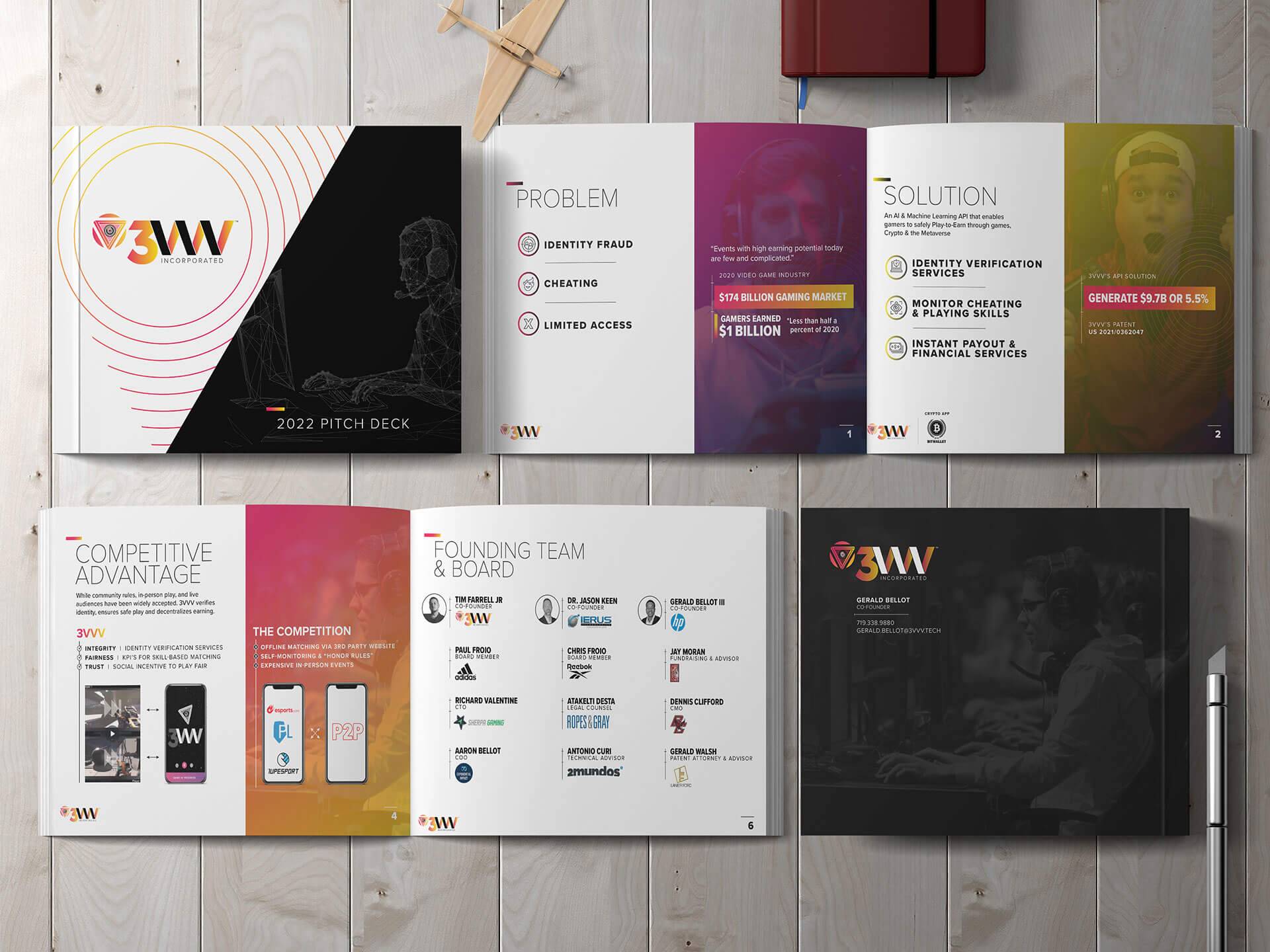
So, you’ve developed a business concept that will allow you to use your skillset, provide innovative solutions to your customers, and rack in some serious profits, right? Awesome! Now, you need to think about now only how you’ll set yourself apart from your competitors, but also how to ensure your target market recognizes, connects with, and remembers your business.
Branding is what makes that happen.
What is your brand? Well, you’re not precisely sure…yet. It’s critical to understand that branding involves more than a well-designed logo, font, and company colors. A brand needs to create an emotional response or need in your market. It needs to tell your company story and convince customers that your business is their best option.

In this guide, we’ll tell you how to style your brand. Read on to understand how to set your brand apart in a memorable way that makes your target audience remember your name.
1. Learn from Well-Known Brand Identity Examples
To further solidify your definition of branding, it helps to take a look at companies that have perfectly developed their brand and loyal customer following.
Apple is all about discovery, being ahead of the next big thing, and taking risks in pursuit of something better. Their logo of a bitten apple perfectly reflects that.
Because of this, people can instantly spot an Apple product from a mile away when they see it.
Nike is another example of an incredibly successful branding strategy.
Their logo—the iconic swoosh, and their slogan, “Just Do It” lets people know what their brand represents. It tells them that Nike is for the fearless, reliable, dedicated, and disciplined. It’s about committing to an idea and seeing it through—despite setbacks and challenges along the way.
These brands have stood the test of time for many reasons. First, the quality of their products is impeccable. And second, their successful branding strategies are impossible to ignore.
Learn from them.
Think about some local brands you like and why you like them. How do they present themselves?
Did you know?
Brand Recognition Impacts Consumer Decisions: Approximately 59% of consumers prefer to buy products from brands they are familiar with. (Source: Nielsen)
2. Get to Know Your Company All Over Again
So, first off, let’s really dig into what your brand is all about. What’s its vibe? What’s its mission? Understanding its core is like knowing its soul.
If you want to create a timeless and successful brand, you have to be willing to seriously question yourself as well as your core values and beliefs. Also, you will need to study tons of consumer data and market research along the way. Now is the time to re-introduce yourself to your company and your market.
Get to Know Your Brand
Remember, branding isn’t just about what your business wants to say—it’s about understanding what your market wants to hear. To understand that, you’ll have to get to know your audience on a deeper level and who you are.
Ask yourself:
- Where do they live?
- How old are they?
- How much income do they have, and in what type of industries do they work?
- Do they have children?
- How much free time do they have?
- What are their pain points?
- What solutions are they seeking?
You’ll also need to consider their beliefs and values, and assess whether they match up with those of your company.
Many businesses are afraid to have an opinion—but in reality, expressing your views is what gets your target market to notice you and resonate with your brand. You can even conduct consumer surveys to allow your market to tell you all of these things themselves.
Finally, consider why you started your company, what you hope to achieve, and how you offer better or different solutions than your competitors.
The Importance of a Target Persona Workshop
A target persona workshop serves as the cornerstone of any successful marketing strategy, offering invaluable insights into the wants, needs, and preferences of your ideal customers. By gathering key stakeholders to delve deep into understanding the characteristics, behaviors, and pain points of your target audience, you lay the foundation for crafting tailored marketing campaigns that resonate on a personal level. These workshops not only provide clarity on who your customers are but also offer direction for product development, messaging, and channel selection. Armed with a comprehensive understanding of your target personas, you can effectively align your marketing efforts to address their specific challenges and aspirations, ultimately driving engagement, loyalty, and business growth. In essence, a target persona workshop isn’t just a meeting—it’s a strategic imperative that empowers your team to make informed decisions and connect with customers in meaningful ways.
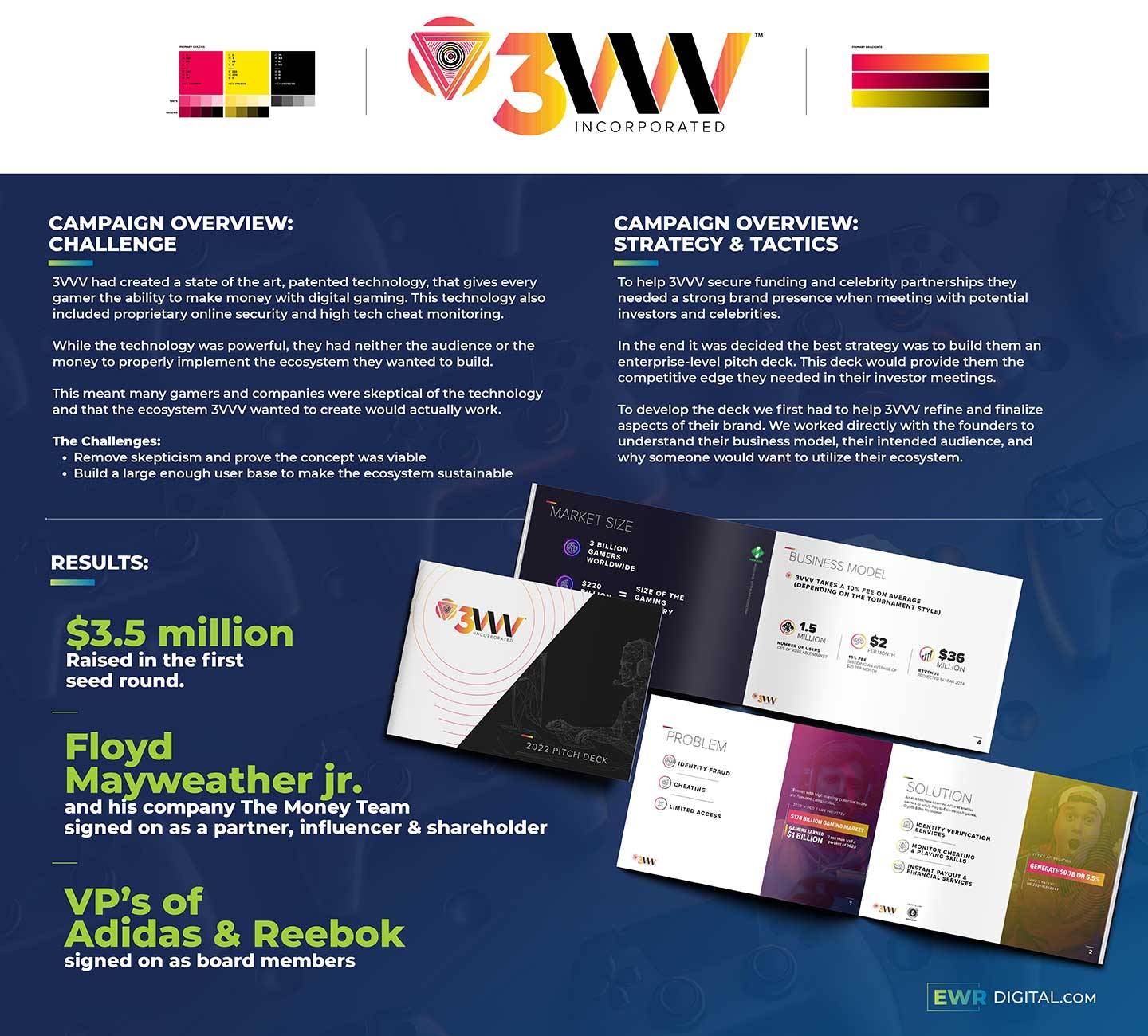
3. Creating Branding Visuals
Did you know?
Visuals Influence Purchase Decisions: 93% of consumers consider visual appearance to be the key deciding factor in a purchasing decision. (Source: SalesForce)
Although we mentioned earlier that your logo isn’t the only part of your brand—it’s still a pretty important component of your branding strategy. To make your logo as recognizable and useful as these famous examples, you’ll need to come up with the perfect central image.
To start, think of three or four words that you can instantly associate with your brand. Next, consider what images you would associate with those words. Maybe you’re a tourism company, and one of your words is “vacation.”
Get Creative with Names and Logos
Time to brainstorm some cool names and design a logo that’s like your brand’s signature look. Something that screams “This is us!” when people see it.
Possible logo images could include a collection of famous landmarks from around the world, international flags, a person relaxing on a beach, or a person boarding a plane. Next, consider the colors you’ll use—make sure you consider the psychology of colors here.We also strongly suggest working with local artists or graphic designers to create your bespoke font from scratch.
This is a fantastic way to differentiate yourself from the competition and increase your brand recognition.
Pick Colors and Fonts That Pop
Choose colors and fonts that feel like your brand’s wardrobe. You want them to catch the eye and leave a lasting impression.
Just like how you choose your clothes to reflect your personality, your brand’s colors and fonts should reflect its essence and leave a memorable impression on anyone who encounters it.
- Colors that Speak Volumes: Colors evoke emotions and associations. For example, blue might convey trust and reliability, while red can symbolize passion or energy. Think about what feelings you want your brand to evoke and choose colors accordingly. Consider a primary color that dominates your brand’s palette, along with complementary colors that accentuate it. Make sure the colors not only look good together but also align with your brand’s personality and resonate with your target audience.
- Fonts with Flair: Just like handwriting, fonts have personality. Some are elegant and refined, while others are bold and playful. The fonts you choose should match the tone of your brand. If you’re going for a sleek, modern vibe, opt for clean, sans-serif fonts. For a more traditional feel, serif fonts might be the way to go. Whichever you choose, make sure it’s legible and works well across different mediums, from your website to printed materials.
- Consistency is Key: Once you’ve chosen your brand’s colors and fonts, stick with them like your signature style. Consistency breeds familiarity, and familiarity breeds trust. Whether someone sees your brand on social media, your website, or a physical product, they should instantly recognize it by its colors and fonts. This helps build brand recognition and reinforces your brand’s identity in the minds of your audience.
- Test and Iterate: Don’t be afraid to experiment with different color combinations and font pairings to find what works best for your brand. Gather feedback from your audience and see how they respond to different choices. And remember, your brand’s wardrobe can evolve over time as your brand grows and evolves. Just make sure any changes still stay true to your brand’s core identity.
Check out this color Pyschlogy palate design by Axelle (AX):
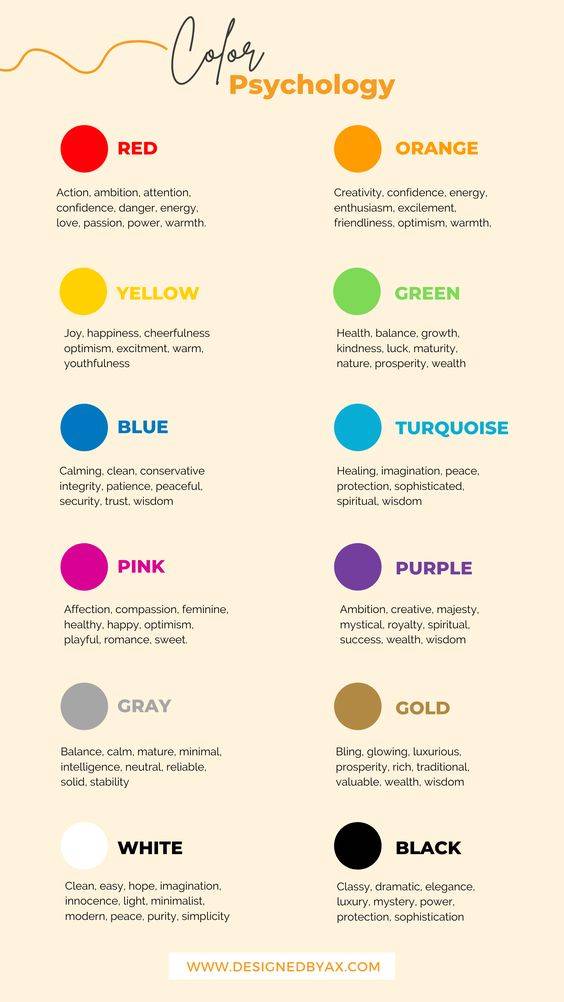
Create All the Goodies
Okay, picture this: you’ve got your brand all figured out—its vibe, its personality, everything. Now it’s time to bring it to life! We’re talking about making all the fun stuff that screams “Hey, this is us!” Think business cards that people can’t wait to hand out, a website that’s so slick it practically sings, and social media posts that stop the scroll. Get those creative juices flowing and let your brand shine in every little detail. It’s like getting dressed up for a big night out—except your brand is the star of the show!
Make Every Interaction Count
Here’s the deal: every time someone comes across your brand, whether it’s on your website, your product packaging, or even just a quick chat with a customer service rep, it’s a chance to make an impression. So make it count! Let your brand’s vibe and values shine through in every interaction. Whether you’re keeping it casual or going for that extra wow factor, make sure it’s unmistakably you. Because every interaction is like a mini-brand ambassador spreading the word about how awesome your brand is!
Emotional Connection Boosts Loyalty: Based on a study by Motista, brands that successfully create an emotional connection with consumers have a 306% higher lifetime value.
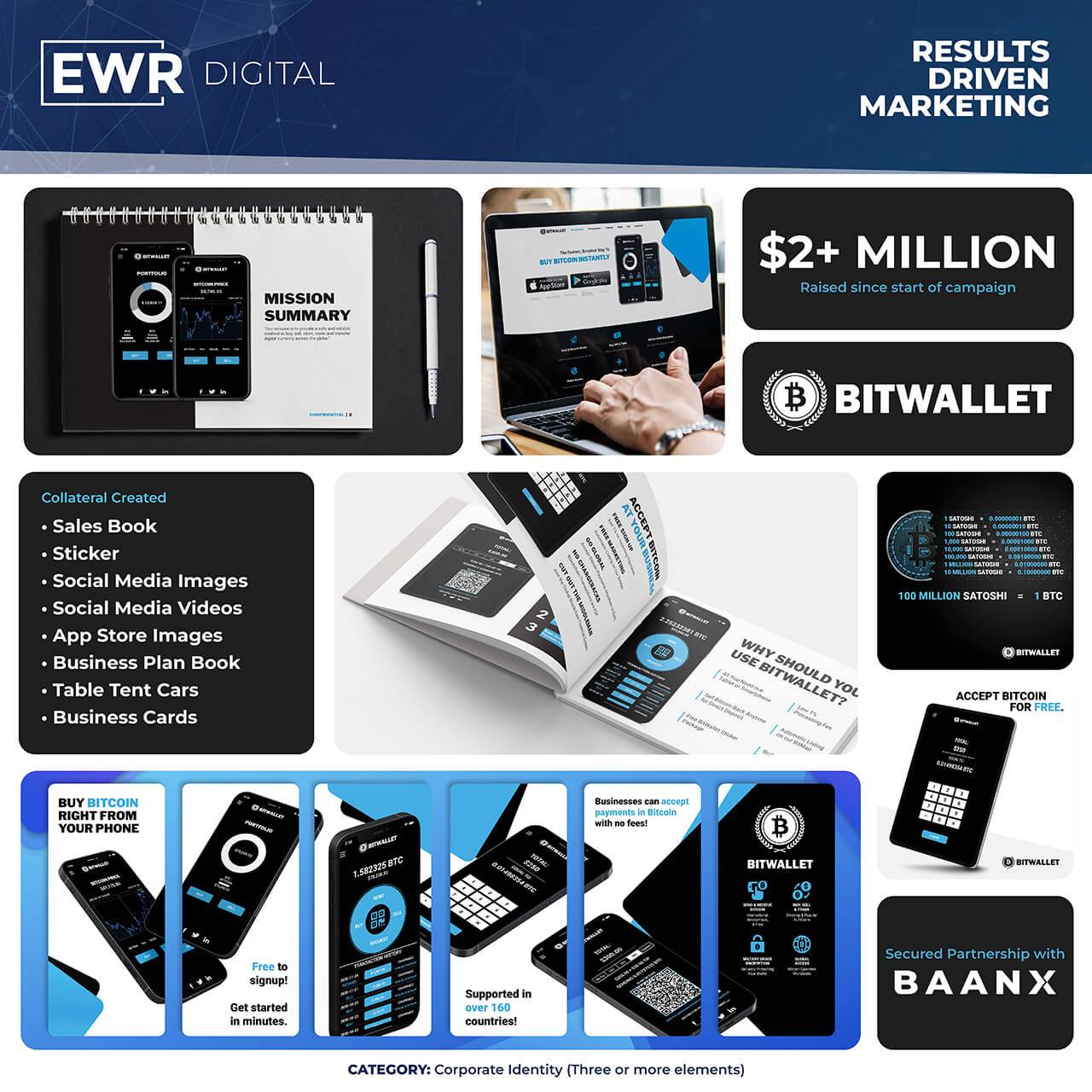
4. Developing Your Brand’s Voice and Tone
Finally, a key part of learning how to brand yourself and your company is deciding how you speak to your customers. For example, if you run an accounting firm, a playful brand voice with a slightly sarcastic, humorous tone wouldn’t be appropriate.
But, if you’re the owner of a board game cafe or a dating agency? A playful brand voice might suit your brand perfectly. Remember, the purpose of your brand’s voice is to convey your company’s overall personality, pace, and vocabulary. Is your brand quirky, authoritative, inspirational, or aspirational? Do you speak in longer sentences full of industry terms and jargon? Or, do you prefer to keep things clear and concise?
Your brand’s voice and tone will determine how to write web content, marketing emails, print ads, and even call scripts for your employees to follow.
Looking for More Guidance on Building a Brand?
- Jeff Bezos, CEO of Amazon: “Your brand is what other people say about you when you’re not in the room.”
- Steve Jobs, co-founder of Apple: “Your brand is the single most important investment you can make in your business.”
- Warren Buffett, CEO of Berkshire Hathaway: “It takes 20 years to build a reputation and five minutes to ruin it. If you think about that, you’ll do things differently.”
- Richard Branson, founder of Virgin Group: “Building a brand isn’t just about selling products; it’s about creating an emotional connection with your customers.”
- Seth Godin, marketing author and entrepreneur: “A brand is the set of expectations, memories, stories, and relationships that, taken together, account for a consumer’s decision to choose one product or service over another.”
Now that you have a stronger grasp on what creating a brand requires, you can start brainstorming, researching, and asking for feedback from your market. However, if you genuinely want to build a brand that stands out, or if you don’t feel like you have the time to do all the work on your own, you don’t have to. Consider hiring a brand expert to help guide you in the right direction.
We’re here to help you develop and implement branding practices that blow your competitors out the water. In addition to helping develop your brand awareness, we can also assist you with SEO, pay-per-click advertising, website analysis and development, and much more.
To get started, all we need is just 20 minutes of your time. Schedule your free consultation call with us today, and learn how we can help you to create a brand that’s impossible to overlook.
If ‘you’re interested in personal branding, you should also check out this book written by our CEO: “Build your Brand Mania” by Matt Bertram. The book will help you transform yourself into an authoritative brand and attract your ideal customers!
Launch and Learn
Alright, it’s showtime! You’ve put in all the hard work to get your brand ready, now it’s time to unleash it into the wild. But here’s the secret sauce: the learning doesn’t stop once your brand hits the streets. Keep your eyes and ears open, listen to what people are saying, and pay attention to how your brand is being received. Feedback is like gold—it helps you see what’s working and what might need a little tweak. So, stay flexible and be ready to roll with the punches as you navigate the exciting world of brand-dom.
Stay True to Yourself
Picture this: your brand is like a compass, always pointing north. It’s got its own personality, its own vibe, and you’ve worked hard to define it. So, don’t let it lose its way! Consistency is your best friend here. Keep checking in to make sure your brand is staying true to its roots. That way, people will always know what to expect when they interact with your brand. It’s like having a loyal friend who’s always got your back—consistent, reliable, and true to who they are.
Building Your Brand and Becoming a Thought Leader
Once you’ve established your brand identity, the journey doesn’t end there—it’s just the beginning. Now, it’s time to embark on the exciting path of brand building. This involves actively engaging with your audience, creating valuable content, and positioning yourself as a thought leader in your industry. By consistently sharing insights, expertise, and innovative ideas, you not only strengthen your brand’s reputation but also establish yourself as a trusted authority in your field. Whether it’s through thought-provoking blog posts, engaging social media interactions, or speaking at industry events, seizing opportunities to showcase your knowledge and expertise is key to cementing your brand’s presence and influence in the marketplace. Remember, building a brand isn’t just about promoting products or services—it’s about creating meaningful connections and inspiring trust through thought leadership and authentic engagement.
